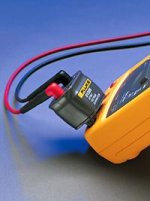Ron Beaufort
Lifetime Supporting Member
yes, a Wiggins tester will indeed provide a load to a TRIAC output – and thus prevent a "high" reading which could (incorrectly) make it APPEAR that the output is constantly "stuck on" – even when the output circuit is perfectly ok ...
here are a couple of previous posts (both in the same thread) related to the downside of using a “wiggy” tester on PLC systems – particularly on 120VAC output modules which are based on TRIAC devices ... (suggestion: read the whole thread if you’ve got time) ...
http://www.plctalk.net/qanda/showthread.php?postid=12803#post12803
http://www.plctalk.net/qanda/showthread.php?p=12891&postcount=19
and there’s a link in the following post that shows the Fluke SV225 “Stray Voltage Adapter” ... this little device will pull an “off” TRIAC output down to about 6 volts ...
this is a lot safer (for the equipment) than using a modified "ignition coil" for testing – which is basically what a Wiggins-type tester amounts to ...
http://www.plctalk.net/qanda/showthread.php?p=224940&postcount=5
party on ...
.

here are a couple of previous posts (both in the same thread) related to the downside of using a “wiggy” tester on PLC systems – particularly on 120VAC output modules which are based on TRIAC devices ... (suggestion: read the whole thread if you’ve got time) ...
http://www.plctalk.net/qanda/showthread.php?postid=12803#post12803
http://www.plctalk.net/qanda/showthread.php?p=12891&postcount=19
and there’s a link in the following post that shows the Fluke SV225 “Stray Voltage Adapter” ... this little device will pull an “off” TRIAC output down to about 6 volts ...
this is a lot safer (for the equipment) than using a modified "ignition coil" for testing – which is basically what a Wiggins-type tester amounts to ...
http://www.plctalk.net/qanda/showthread.php?p=224940&postcount=5
party on ...
.

Last edited:



